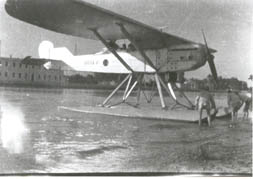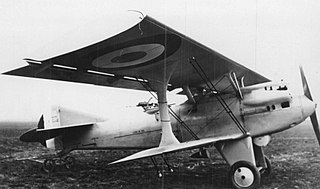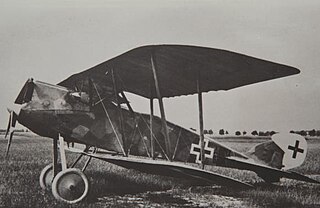
The Aero A.12 was a Czechoslovakian biplane light bomber and military reconnaissance aircraft manufactured in small numbers shortly after World War I. Although reminiscent of the Hansa-Brandenburg-designed aircraft that Aero was building during the war under licence as the Ae.10, the A.12 was the company's own design. It is perhaps most significant as the direct descendant of the highly successful A.11 and its various derivatives. An example of the type is preserved at the Letecké Muzeum in Kbely.

The Aero A.23 was a Czechoslovakian airliner of the 1920s. Aero Vodochody had produced the first Czech airliner, the A.10, four of which had served with ČSA, the national airline. The A.23, another biplane, was bigger, more powerful, and could carry more passengers.

The IAR 14 is a Romanian low-wing monoplane fighter-trainer aircraft designed before World War II.

The WZ.X was the Polish reconnaissance aircraft designed in the mid-1920s and manufactured in the Centralne Warsztaty Lotnicze (CWL) - Central Aviation Workshops in Warsaw. It was the first combat aircraft of own design built in Poland, in a small series.

The Avia BH-11 was a two-seat monoplane sport aircraft designed and produced by the Czechoslovakian aircraft manufacturer Avia.

The Avia BH-28 was a military reconnaissance biplane aircraft developed in Czechoslovakia in 1927 to meet a requirement for such an aircraft by the government of Romania. Avia based the design on their BH-26, but replaced the engine with an Armstrong Siddeley Jaguar, as specified in the requirement. The completed aircraft was taken to Bucharest for demonstration, but no order ensued, and this prototype was the only example constructed.

The Avia BH-29 was a trainer aircraft built in Czechoslovakia in 1927, in the hope of marketing it to both the Czechoslovakian Army, and to Czechoslovakian Airlines as a primary trainer. It was an conventional design, an unequal-span biplane of wooden construction and with tailskid undercarriage. The pilot and instructor sat in tandem open cockpits. A more powerful version was built, powered by a 120 hp (89 kW) Walter NZ-120 radial engine.

The Breda A.7 was a reconnaissance aircraft developed in Italy for use by the Regia Aeronautica in 1929. It was a braced parasol monoplane of conventional configuration with tailskid undercarriage. The pilot and observer sat in tandem, open cockpits. A single prototype of a long-range example, originally designated A.7 Raid and later A.16 was also constructed, but the air force showed no interest in it.

The PWS-1 was a Polish two-seat fighter and reconnaissance aircraft constructed by Podlaska Wytwórnia Samolotów (PWS) in 1927. It remained a prototype for its entire lifespan.
The Beardmore W.B.II was a British biplane fighter prototype of the 1910s.

The Levasseur PL.5 was a carrier-based fighter produced in France in the late 1920s, in response to the 1924 AMBC.2 specification issued by the Service Technique de l'Aéronautique (STAé). It was a conventional, single-bay sesquiplane that carried a crew of two in tandem, open cockpits. Like other Levasseur naval designs of the day, it incorporated several safety features in case of ditching at sea. Apart from small floats attached directly to the undersides of the lower wing, the main units of the fixed, tail-skid undercarriage could be jettisoned in flight, and the underside of the fuselage was given a boat-like shape and made watertight.

The PWS-5 or PWS-5t2, was a multi-seated Polish liaison aircraft, developed in 1928 by PWS.

The Levy Biche LB.2 was a single seat French sesquiplane fighter aircraft designed to be used from aircraft carriers. With a watertight fuselage, jettisonable wheeled undercarriage and small under-wing floats, it could survive emergency sea touchdowns; it could also be fitted with seaplane type floats.

The Wibault 10/II Tramontane was a two-seat reconnaissance aircraft designed and built by Société des Avions Michel Wibault in France for the French military 1923 A.2 competition for a 2-seater reconnaissance aircraft.

The de Marçay 2 C1 was a prototype single-seat biplane fighter designed in France and first flown in 1919. It did not go into production.

The Les Mureaux 3 C.2 and Les Mureaux 4 C.2 were French two seat, parasol winged fighters, flown in 1927-8, which differed only in their engines. They were developed into near identical army co-operation types, the ANF Les Mureaux 130 A.2 and ANF Les Mureaux 131 A.2, in 1929–31.

The Villiers XXIV or Villiers 24 CAN2 was a French army night fighter most notable as the first French military aircraft to be fitted with leading edge slats.

The Borel-Boccaccio Type 3000, also known as Borel C2, was a two-seat fighter designed and built in France to a 1918 C2 specification.

The Aviatik C.IX was a prototype German observation aircraft built by Aviatik in the final months of World War I.
The Caproni Ca.66 and Caproni Ca.67 were Italian night bomber aircraft designed to re-equip the post-World War I Regia Aeronautica.



















